Embroidery is often seen as a lowly art form – if it is seen as an art form at all – so it has been a real joy to discover just how many people are excited enough to blog about what they create and what has inspired them. In general I have found the visual images in blogs, on Flickr, etc. stimulating almost to the point of overload, and along with this, when I’ve stayed long enough to read the texts, I have greedily accumulated a rich booty of clever tips.
And when I say clever tips, I mean it. Only the other day I learned how to ensure that your thread doesn’t knot. From Natalie Chanin’s blog, I went to her book (Alabama Stitch Book) and discovered “loving” your thread. I wasn’t too sure about the name and I wasn’t sure that I use thread in quite the way she does, but it is certainly true that, having threaded the needle, gently running the thread through thumb and index finger several times results in thread that DOES NOT KNOT. I’m still not sure that I can refer to the process as “loving” my thread, except in a sort of ironic way, but knowing this technique will change my life and make me a much nicer person.
So, this blog will be a bit of a mishmash of things that I find interesting and stimulating. I’m a novice with the technical alchemy beneath my fingers and as yet there are quite a few things I cannot do. I would like to make links to other websites, blogs, etc. but I have insufficient bravery for that as yet.
Much of my embroidery has been influenced by nature, especially flowers, shells, birds and butterflies. Alongside photos of my work, I shall include brief botanical details, literary snippets and anything else interesting and relevant. As I look over my work, I see that I have my favourite subjects. I come back to honeysuckle again and again, freehand drawing taking liberties with the basic form. Sometimes it doesn’t even look like honeysuckle any more but I prefer that to following charts, diagrams or transfers. It does mean wayward pencil lines are often visible but I’ve found that there’s very little that doesn’t survive gentle hand washing. (Tinned tomato soup is the exception as when dropped on coloured silk it acts like bleach and removes the colour completely. Fortunately I was embroidering a dress with leaves and feathers at the time and a random floating feather was seen as rather charming. Phew.)
Briefly to the botanical. Honeysuckle, known to gardeners as Lonicera, is so named after Adam Lonicer, a German botanist and herbalist who seemed to prefer the study of plants and their uses to mathematics in which he held a professorial chair. How wise.
In summer few can pass by what may look like a tangled bird’s nest of a hedge and not be arrested by the sweet nostalgia-triggering scent of the honeysuckle. And what is true for humans is even more true of other forms of wildlife. Birds find the Gordian knot of stems ideal protection for their nests; bees, butterflies and moths drink deeply of the nectar on offer while at the same time the powderpuffy bits of their bodies pick up the pollen and, in a biological quid pro quo, transfer it to another honeysuckle along the way. Monty Don tells us that the leaves are eaten by white admiral and marsh fritillary butterflies, although “not in a destructive way like aphids” – so that’s alright then.
Flanders and Swann, responsible for many a piece of random and not wholly joined up scientific information, are spot on as to the respective spiralling habits of the honeysuckle (clockwise) and the bindweed (anticlockwise). Their poignant song, Misalliance, catalogues the love affair between the smitten plants.
“Rooted on either side of the door, one of each species grew,
raced towards the window ledge above.
Each one corkscrewed to the lintel in the only way it knew,
Touched tendrils, smiled, and fell in love.”
Class snobbery and political tension cast a cloud over the cottage door as the honeysuckle parent stock declare the bindweed,
“…….. uncultivated, of breeding bereft.
We twine to the right while they twine to the left.”
Undeterred, the young lovers loosen tendrils and prepare for elopement, arrested briefly by the wisdom of a priestly passing bee, who urges them to consider any product of their union.
“Poor little sucker, how will it learn
When it is climbing, which way to turn.
Right, left, what a disgrace,
Or it may go straight up and fall flat on its face.”
Sadly, it all ends disastrously but I’ll leave your appetite whetted for its conclusion. Try YouTube or Spotify, or something you know more about than I do. There only seemed to be one option on YouTube but I didn’t feel the video that went with it added very much. Do try it yourself as the song is delightful, especially if you can imagine Flanders and Swan performing it in their dinner jackets and with their inimitable style.
To deaden the romance completely, it seems the mystery of these divergent climbers has now been solved. Researchers have discovered a molecular mechanism that determines the direction of twist which varies according to the presence of certain proteins that are involved in the formation of plant cell walls. I am not at all sure my honeysuckles twine correctly as I’ve never meant them to be botanically accurate. But I might be more careful in future and, anyway, it’s good to know these things.
I would like to say that no living creature has been harmed in the creation of this post (let alone the blog itself) but it would not be true.
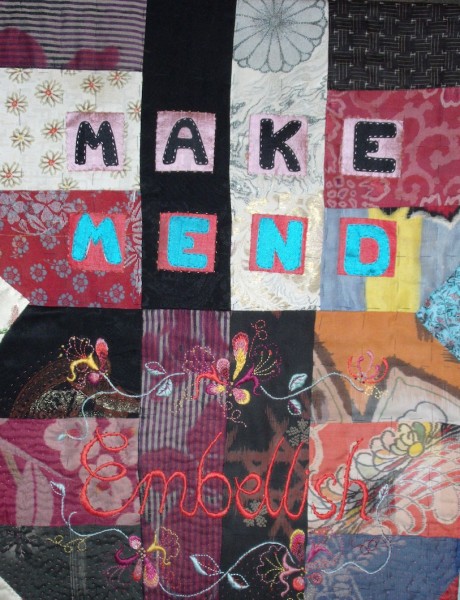
Make, mend and embellish quilted wall hanging with honeysuckle embroidery. Silk appliqué on antique silk Japanese kimono fabric.

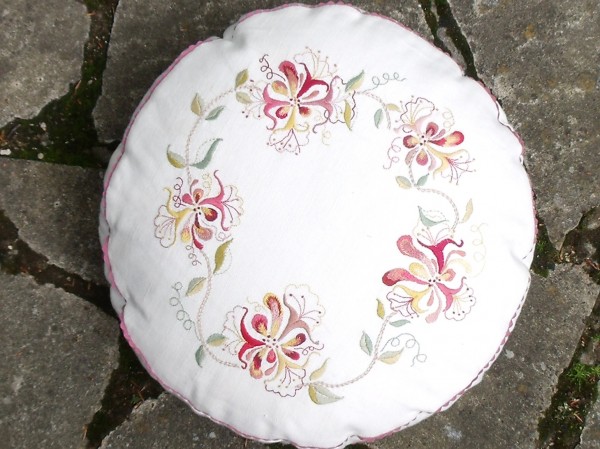
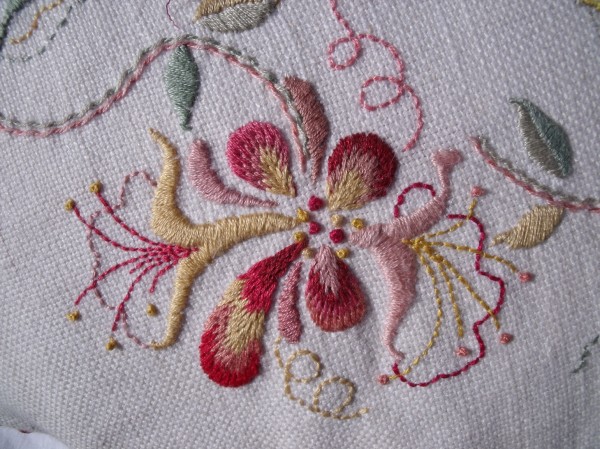
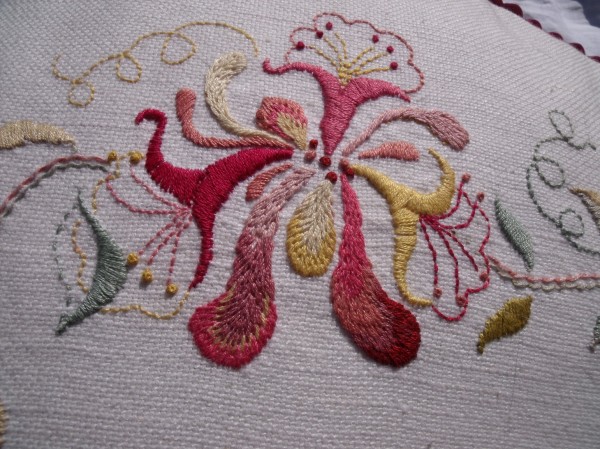
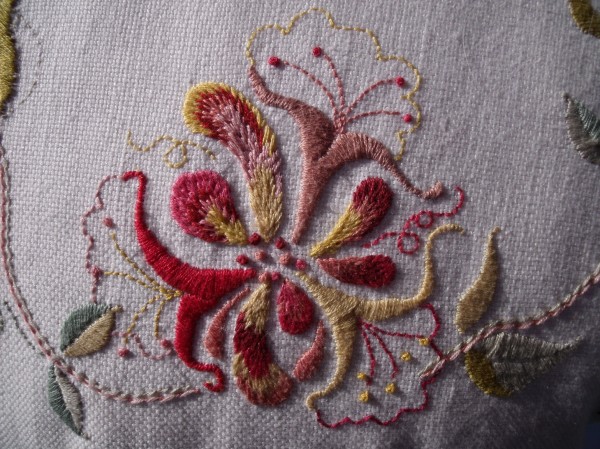
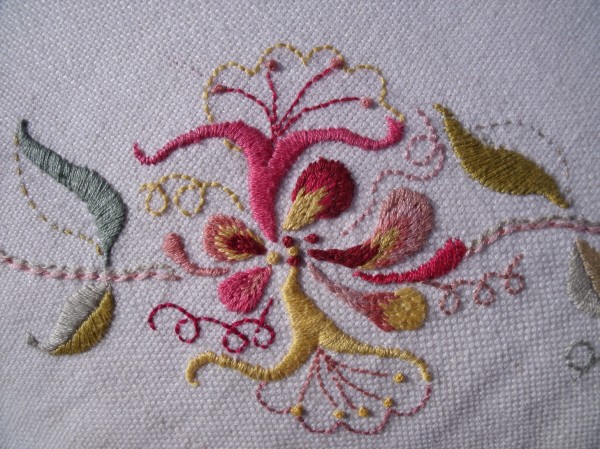
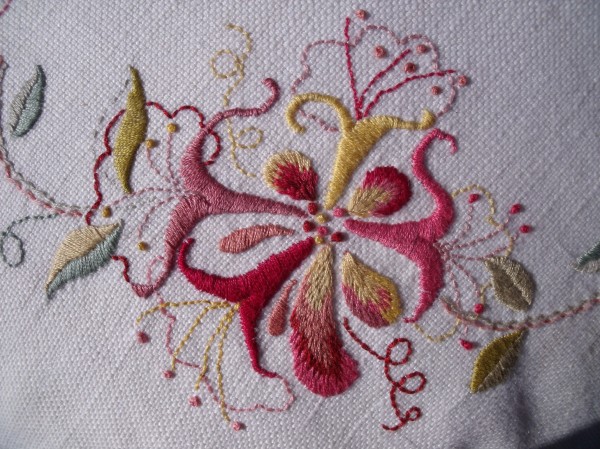
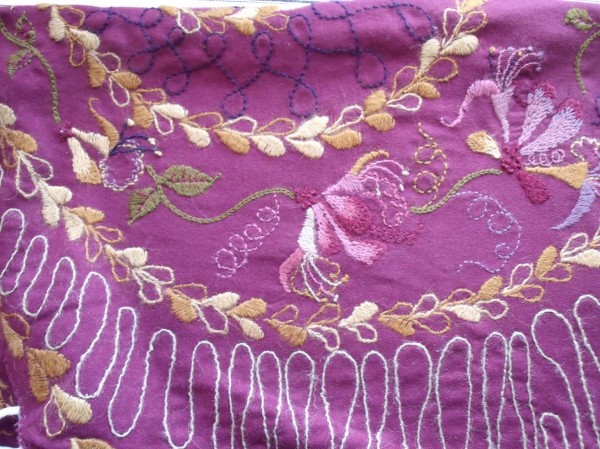
9 Comments
i could spend days looking at the details of each of you work and it is presented so beautifully! i hope this is really just a start that there are many more to come. if you are doing a simpler project, do you think you put step by step illustration on the blog? one thing i have learned from food bloggers is that photography makes a big difference. so spend time looking at your lighting and set up can makes your work looking even more wonderful.
lots of love
xj
Thank for your comments, Xiaojuan. I intend to take photos of work in progress in the future, but until recently I’ve not had enough daylight hours to take photographs – and now even daylight is unreliable. Then, sometimes there’s such a deadline to get things done, that finding time to photograph anything but the finished item is difficult. This is a steep learning curve.
Mary
Hi Mary
Mum and I read your blog (Isabella and I are visiting for the week), and it is so beautiful! You have such a gift! Can’t wait for more. Much love to you and David x
Congratulations they are lovely,still have my shirt glad you at last using your talents..
Using your talent
What a lovely blog! I am so addicted that I have decided to read all the archives and posts you have ever written. I find your style of writing enchanting and your embroidery exquisite.
What a smashing comment! This morning I shall pick up my needle with renewed zeal. Thank you, Mildred.
I have much enjoyed discovering your blog, is it possible to subscribe to it? You write beautifully , so simple and creatively about your work and life.
Many thanks
Janet
This is a really wonderful comment to have, Janet. Thank you for getting in touch.
My son in law is alerted to my posts by something called an RSS feed which you can subscribe to. He doesn’t know how to do this but he’s going to ask technical people in his office how easy it is to do this. I will let you know when he reports back.
Failing that, I now usually blog once a week, aiming to do it on a Friday, so you could just pop by sometime after that.
3 Trackbacks
[…] about it any more once the embroidered item has left may hands. However, I have to admit that the cushion I have kept for myself is whisked off the bed at night and placed on an ottoman. It is also true […]
[…] covered walkways to ensure its sweet scent pervaded the air. I devoted two posts of May 2012 (here and here) to the honeysuckle and there I mentioned that it was the emblem for love and marriage, […]
[…] Honeysuckle, embroidery and all, was also the subject of my first ever blogpost. […]